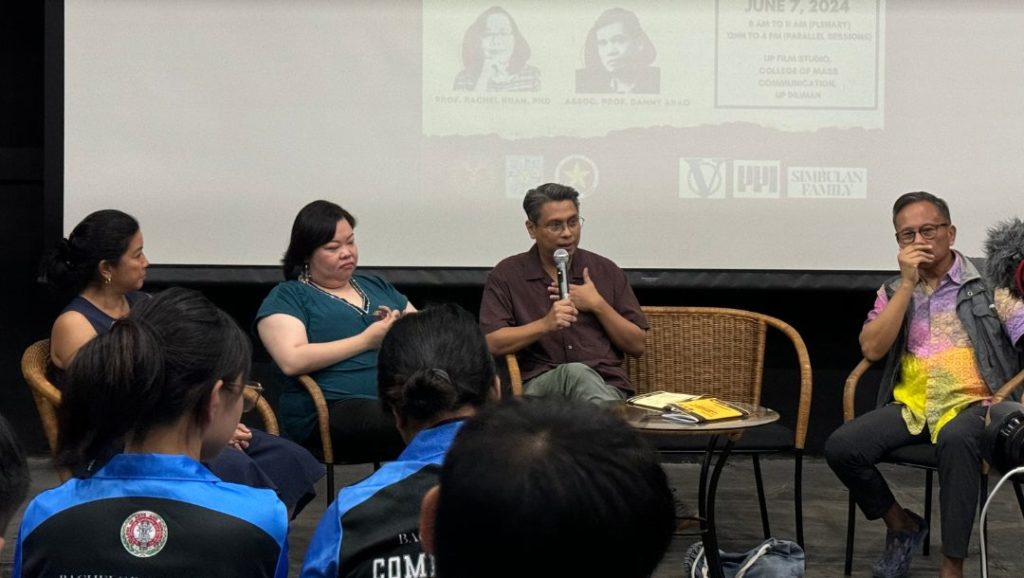

Artificial intelligence (AI) could be used to supercharge disinformation in the upcoming 2025 midterm elections, media experts and veteran journalists warned during a research conference at the University of the Philippines (UP) College of Mass Communication on Friday, June 7.
Journalism professor Rachel Khan, a leading academic in disinformation studies, explained that swift advancements in deep learning increases the risk of deepfakes or manipulated photos and videos becoming more prevalent in social media, as already shown in other countries currently in their election periods.
“We’re seeing in the elections in the United States and India, you have deepfakes of celebrities endorsing politicians even if they’ve never done it. So, that’s what we really need to watch out for,” Khan told over 200 journalism and communication students from 25 universities across the country who participated in the 2024 Philippine Journalism Research Conference (PJRC).
Debunking deepfakes and other AI-generated disinformation is a real challenge to fact-checkers, given the limited capacity of their tools and the reality that the verification process takes a lot of time, Khan added.
Howie Severino, editor-at-large of GMA Integrated News and co-founder of the Philippine Center for Investigative Journalism, said that while newsrooms explore how AI could help in covering the elections, they should also prepare strategies to counter how bad faith actors would abuse AI to spread lies or twist facts.
“We’ve seen disinformation, how difficult it is [and] how it has affected politics the world over. So, imagine AI doing this but multiplied many times over. We have to start thinking about that,” added Severino, who himself previously became a victim of deepfake advertising.
Apart from the public, the media has also become a victim of disinformation, which “undermined its credibility and sowed distrust among audiences,” according to OneNews anchor and PumaPodcast founder Roby Alampay.
He added that journalists cannot effectively combat falsehoods on their own and would need to collaborate with multiple groups in society, especially those from the youth and education sectors.
Journalism professor Danilo Arao highlighted the role of media and information literacy as well as voter education to empower audiences and civil society with the proper knowledge on potential election risks that AI could bring about.
Arao, also a convenor of election watchdog Kontra Daya, raised concerns over a Commission on Elections (Comelec) proposal to ban the use of AI in the forthcoming polls.
In a May 2024 memorandum, Comelec chair George Garcia requested the poll body en banc to ban AI and deepfakes in campaign materials for the 2025 elections, saying it compromises election integrity.
“Where is the wisdom in banning a tool that can be either useful or weaponized?” Arao asked. “Disinformation is not perpetrated by technology. What we should target are the perpetrators or systematic disinformation networks.”
As new technologies get integrated into journalism, Manila Standard managing editor and Philippine Press Institute seminar director Joyce Pañares reminded conference delegates that it is crucial to upskill and be tethered to core journalistic values.
“We need to be agile, have the willingness to learn and think critically so we won’t easily get fooled when we talk to disinformation [actors] or to politicians who are lying,” she added.
With AI reshaping how news organizations do their work, Severino emphasized that the role of journalists’ have evolved from just being information gatekeepers to “eagle-eyed guides” that point the audiences to facts and truth.
“It’s our job to verify, call out [and] present the truth. That’s a higher value even than telling stories, to apply that kind of discipline to information to be able to tell [the public] whether something is true or false,” he added.
Winners
The annual PJRC, which began in 2013, is organized by the UP College of Mass Communication together with the Polytechnic University of the Philippines (PUP) and the University of Santo Tomas. Undergraduate students with outstanding works in academic research, investigative journalism, news documentary, special projects and photo essays are awarded with the Chit Estella Memorial Awards for Journalism.
The award is named after the late UP journalism professor, veteran journalist and VERA Files founding trustee Lourdes “Chit Estella” Simbulan, who died in a car crash on May 13, 2011. The year following her violent death, VERA Files and the Simbulan family partnered with the UP Journalism Department for what started out as the Chit Estella Journalism Research Awards in her honor.
Among more than 200 entries submitted this year, stories about jeepney modernization, retail workers and indigenous communities stood out, along with studies on the coverage of former president Rodrigo Duterte’s drug war and the storytelling techniques of journalists turned vloggers.
Here are this year’s winners of the Chit Estella Memorial Awards for Journalism:
- Journalism Research (General Academic Research) — Alexandra Elicano, Joane Marie Beldua and Ma. Francesca Gines from Ateneo de Manila University for their study entitled “Holding the Line: How Filipino Trauma Reporters Construct the Meaning of Journalism in their Coverage of the Duterte Administration’s War on Drugs Campaign”
- Journalism Research (New Media, AI and Other Emerging Trends) — Guinevere Mariedelle Latoza from UP Diliman for her research called “The journalist can be a vlogger, too: An exploratory study on the storytelling techniques and ethics that guide Filipino journalist-vloggers”
- Special Projects in Journalism — Albert Josef Lirio from UP Diliman for his project “Medyo Media”
- Photo Essay — Therese Diane Villanueva from De La Salle University for her photo essay “Walang Buntot ang mga Mangyan: Kabang-yaman ng Kultura, Buhay at Gawain ng Buhid at Hanunuo Mangyan”
- Investigative Journalism — Eirene Manatlao, Patricia Kate Azicate, Marge Nicole Baldo, Bella Dela Merced and Mayen Medroso from PUP Manila for their investigative report “A SILENT THREAT: Chemical risk leaves workers unaware”
- News Documentary — Almira Coleen Mendoza, Andrea Nicole Ebdane and Oliver Judal Jr. from UP DIliman for their news documentary “Para, Saan? Ang Kwento ni Ka Nolan”


